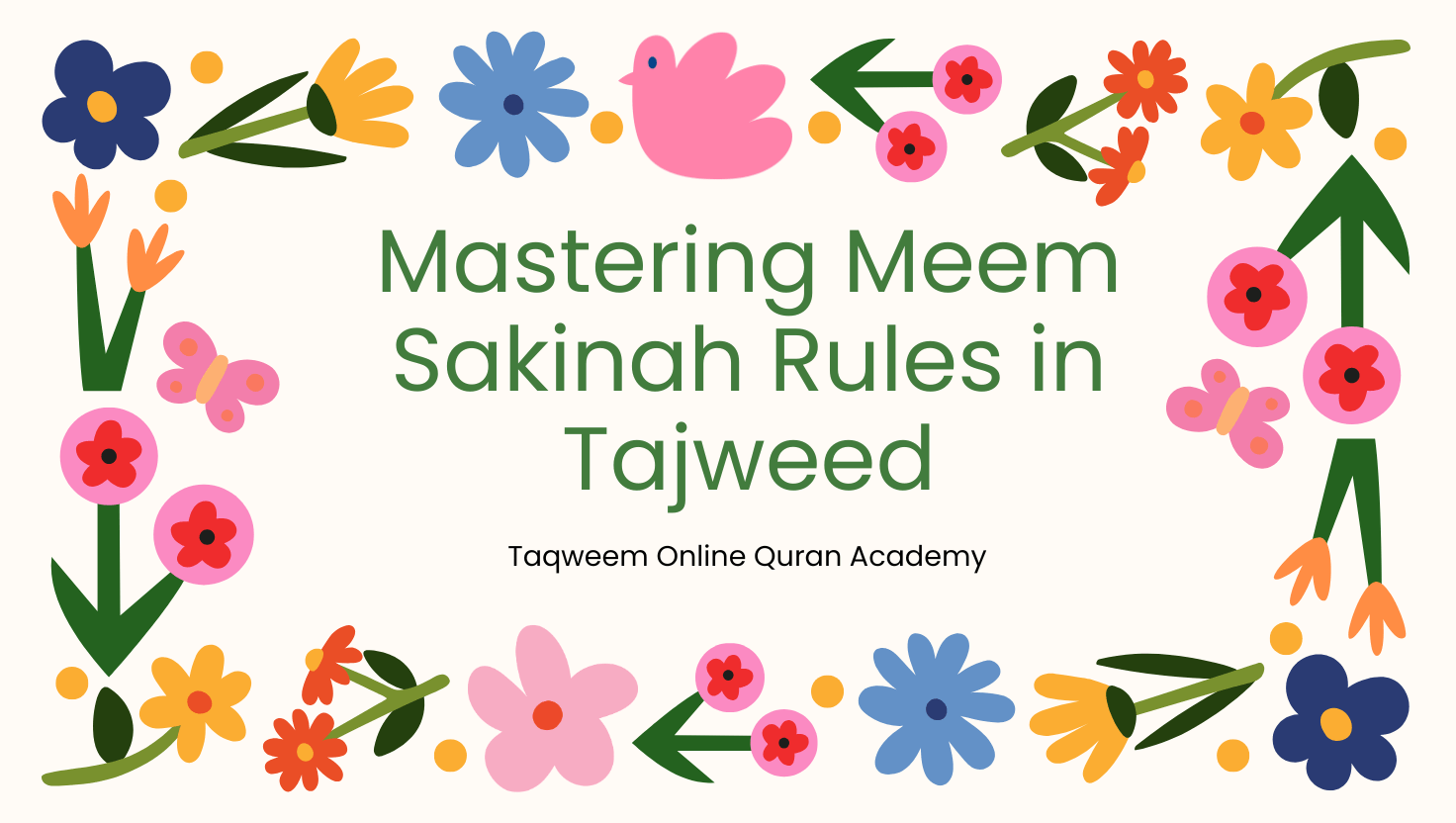Table of Contents
ToggleWhat Is Meem Sakinah?
“A moment of stillness in the flow of divine speech.”
In the heart of Tajweed—where each letter of the Quran is treated like a sacred trust—there is a rule that seems so soft, so delicate, that many overlook its power: Meem Sakinah.
But for those who pause, who listen with their heart, Meem Sakinah is more than just a rule. It’s the gentle hum of a Meem (م) left in sukoon—silent yet alive. A Meem that carries no vowel, but still holds a role. It whispers in the recitation, testing the precision of your tongue, your breath, your soul.
And like all divine subtleties, it comes with its own rhythm. Three sacred rules:
These aren’t just terms. They’re spiritual etiquettes in the court of Allah’s words. Let me take you through them—not like a textbook, but like someone sitting beside you, sharing what they’ve come to love.
Ikhfaa Shafawi – The Concealed Meem
“When the Meem hides behind a veil of humility.”
Ikhfaa Shafawi means “concealment with the lips.” When a Meem Sakinah is followed by the letter Baa (ب), we do not pronounce the Meem clearly. Nor do we merge it fully. Instead, we hide it gently, letting the sound echo lightly through the lips—like a secret being softly passed in prayer.
It’s not suppression. It’s humble surrender. As if the Meem knows it must lower its presence when Baa enters. You feel the breath between your lips, that light nasal vibration, and then—Baa comes in.
Think of the word:
تَرْمِيهِمْ بِحِجَارَةٍ
Here, Meem and Baa meet. The lips close slightly, but not with the firmness of clarity or the tightness of merging. They just… whisper.
Idgham Shafawi – The Merging Meem
“When two Meems embrace as one.”
This is perhaps the most poetic of the three. When Meem Sakinah is followed by another Meem (م), the two merge, becoming one long humming sound.
There’s no resistance. No hesitation. Just union.
لَهُمْ مَّغْفِرَةٌ
Here, the Meem at the end of “لَهُمْ” and the Meem at the start of “مغفرة” merge seamlessly. You hold the Meem slightly longer, letting the nasal sound resonate gently—like a lullaby recited on the tongue.
This rule reminds me of the concept of unity in Islam. Two identical letters, becoming one voice. It’s softness. It’s peace. It’s surrender.
Izhaar Shafawi – The Clear Meem
“When the Meem speaks with dignity and clarity.”
And then, there is Izhaar Shafawi: clarity.
When the Meem Sakinah is followed by any letter except Meem (م) or Baa (ب), you pronounce it clearly and with respect. The lips meet. The sound comes out naturally. No hiding. No merging.
It is as if the Meem stands tall, firm in its identity, humbly recited yet boldly heard.
An example?
نَعِمَتٍ مِّنْ رَبِّهِمْ
The Meem in “مِّن” follows this rule if not met with Meem or Baa. And so it’s pronounced clearly.
Izhaar is the default dignity of the Meem. It doesn’t try to blend. It doesn’t hide. It honors its space in the Divine Words.
A Spiritual Reflection: Why Meem Sakinah Matters
For many, Tajweed feels like a science. Rules. Terms. Charts.
But I’ve come to see it differently.
Tajweed is adab with Allah’s words.
And Meem Sakinah is a test of your adab in the subtlest of ways.
It teaches you when to hide your voice, when to merge with humility, and when to stand with clarity. It’s about precision wrapped in spirituality.
A letter that could go unnoticed—but in the Quran, even silence has grammar. Even breath has discipline.
When You Learn This With a Teacher, It Changes Everything
I tried learning these rules from books. But it wasn’t until I heard my teacher recite with love, with softness, that I truly felt Meem Sakinah.
And if you’re seeking that same connection—the living warmth of learning Tajweed from someone who loves the Quran deeply—then let me recommend someone sincerely:
Taqweem Online Quran Academy – Where the Quran Comes to Life
Whether you’re starting fresh or refining your Tajweed, Taqweem Online Quran Academy is not just a place to learn—
It’s a place to connect.
-
One-on-one lessons with native teachers
-
Deep focus on Tajweed (including Meem Sakinah rules!)
-
Flexible timings for your schedule
-
Spiritual warmth and sincerity in every session
Let your Quran recitation be more than correct—let it be beautiful.
Start your journey with Taqweem Online Quran Academy and let the Meem whisper to your heart.

FAQs
What are the rules of Meem Sakinah in Tajweed?
Meem Sakinah has three main Tajweed rules:
-
Izhar Shafawi (clear pronunciation)
-
Idgham Shafawi (merging with ghunnah)
-
Ikhfa Shafawi (concealment with ghunnah)
These apply when a sukoon ( ّْ ) appears on the letter Meem (م) and it is followed by specific letters.
What is Meem Sakinah in Urdu Tajweed?
Meem Sakinah کا مطلب ہے وہ میم جس پر جزم ہو (سکون ہو)، اور اس کے بعد آنے والے حرف کے لحاظ سے تین تجوید کے قاعدے لاگو ہوتے ہیں: اظہار شَفَوی، ادغام شَفَوی اور اخفاء شَفَوی۔
What are the 3 rules of Meem Saakinah with examples?
-
Izhar Shafawi – Clear Meem, e.g. وَهُمْ مُّفْلِحُونَ
-
Idgham Shafawi – Merge Meem with Meem + ghunnah, e.g. كُنْتُمْ مَّعَنَا
-
Ikhfa Shafawi – Hide Meem with ghunnah before ب, e.g. تَرْمِيهِم بِحِجَارَةٍ
What is Izhar Meem Saakin example in Quran?
An example is:
وَهُمْ فِيهَا خَالِدُونَ
Here, the Meem with sukoon is clearly pronounced because the next letter is not Meem or Ba.
What is an example of Meem Saakin Idgham in Quran?
In the verse:
كُنْتُمْ مَّعَنَا
The Meem Sakinah is followed by another Meem, so it is merged with a nasal sound (ghunnah), applying Idgham Shafawi.
What are some examples of Meem Sakinah in the Quran?
Here are 3 common examples:
-
تَرْمِيهِم بِحِجَارَةٍ – Ikhfa Shafawi
-
كُنْتُمْ مَّعَنَا – Idgham Shafawi
-
هُمْ فِيهَا – Izhar Shafawi
What is Izhar Shafawi in Tajweed with example?
Izhar Shafawi means to pronounce the Meem Sakinah clearly without nasalization when followed by any letter except Meem (م) or Ba (ب).
Example: لَهُمْ أَجْرٌ
What are the 12 Tajweed rules in Islam?
There are more than 12 Tajweed rules, but major ones include:
-
Noon Sakinah Rules (Izhar, Idgham, Ikhfa, Iqlab)
-
Meem Sakinah Rules (Izhar, Idgham, Ikhfa)
-
Qalqalah
-
Ghunna
-
Madd (lengthening)
-
Tafkhim & Tarqiq (heavy/light letters)
What is the meaning of Sakinah in Tajweed?
Sakinah refers to a letter with a sukoon ( ْ ), meaning it’s read without a vowel. For example, in Meem Sakinah, the Meem has no harakah and its pronunciation depends on the letter after it.
What’s the difference between Noon Sakinah and Meem Sakinah?
-
Noon Sakinah has 4 rules: Izhar, Idgham, Ikhfa, and Iqlab.
-
Meem Sakinah has 3 rules: Izhar Shafawi, Idgham Shafawi, and Ikhfa Shafawi.
Also, Noon rules apply to all letters, while Meem rules are more specific to Meem and Ba.
What does Meem mean in Tajweed?
In Tajweed, Meem (م) is one of the Arabic letters. When it appears with a sukoon, it’s called Meem Sakinah, and it follows 3 special pronunciation rules to ensure proper Quranic recitation.
Conclusion: Tajweed is Love, Not Just Law
When I sit with my Mushaf now, and I see that little Meem with sukoon, I don’t rush. I pause. I breathe.
Because I know:
This tiny letter has a message.
And in its stillness is a world of humility, beauty, and precision.
May Allah make us from those who honor His words—not just in loud verses, but in the whispers between them.
Ameen.







